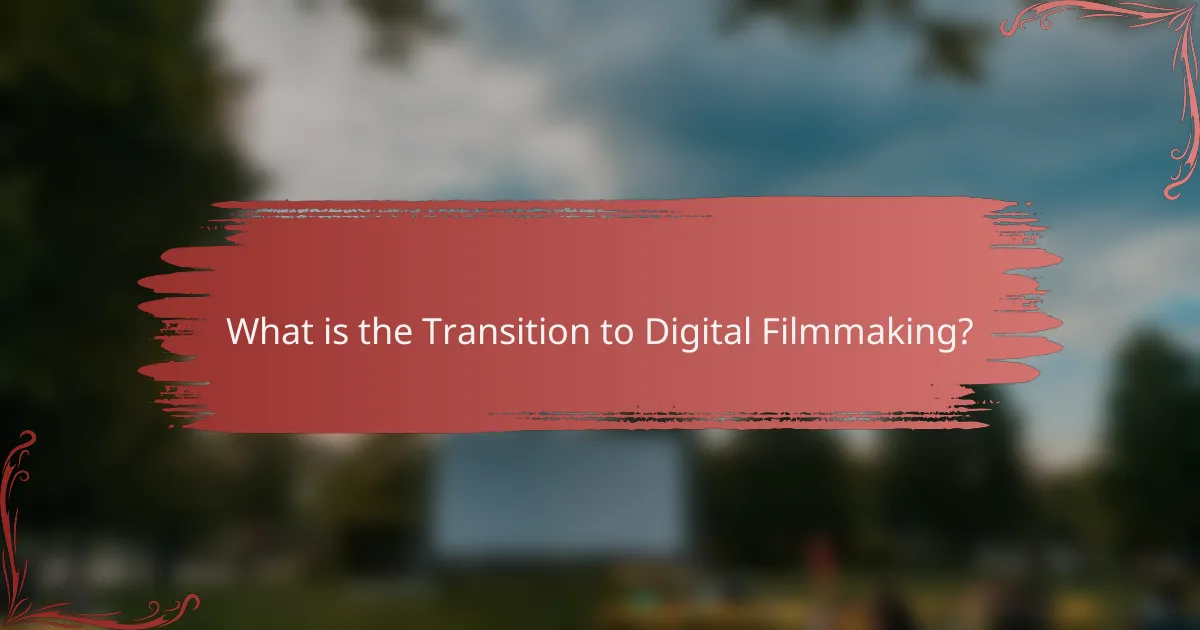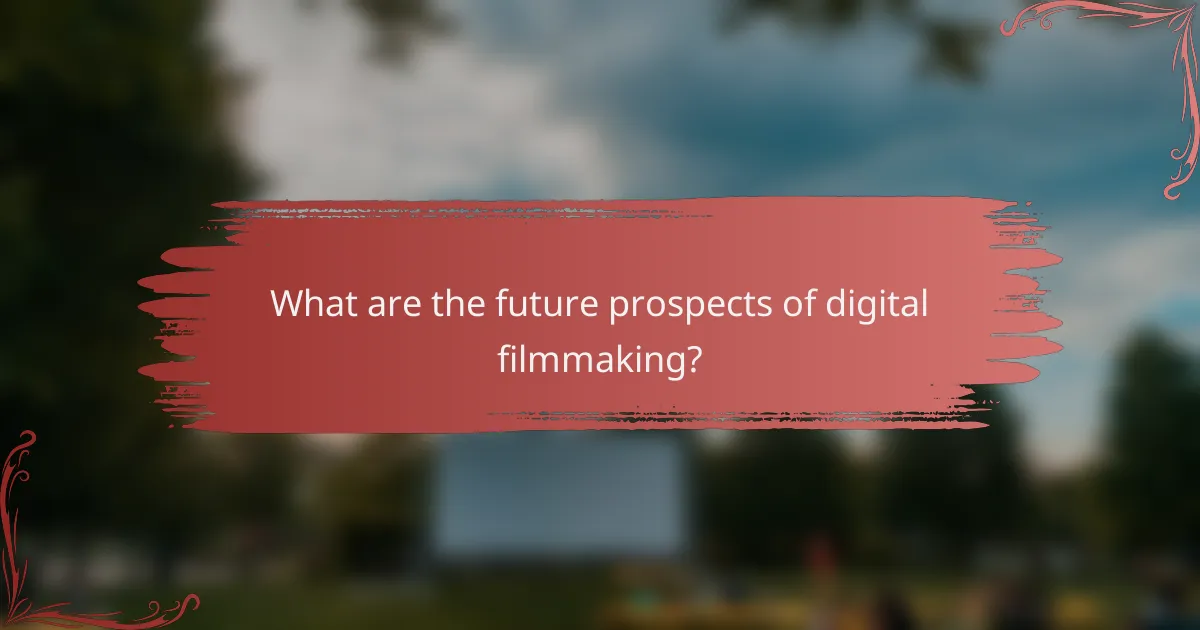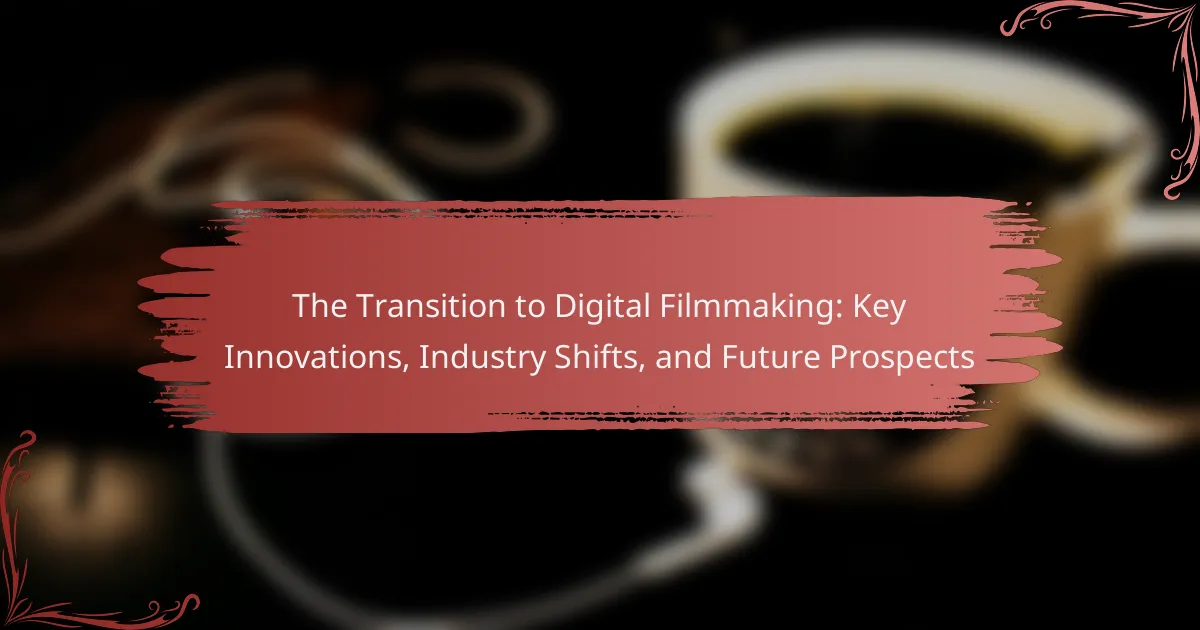The transition to digital filmmaking marks a significant shift from traditional film-based production to digital technology, which began in the late 1990s and accelerated in the 2000s. This evolution has led to the widespread adoption of digital cameras and editing platforms, enhancing the efficiency and accessibility of filmmaking, particularly for independent creators. By 2012, over 90% of films were produced digitally, revolutionizing distribution methods and leading to the rise of streaming services. The article explores key innovations in digital filmmaking, industry shifts, and future prospects, highlighting advancements in camera technology, the impact of virtual and augmented reality, and the democratization of filmmaking through affordable tools and increasing demand for original content.

What is the Transition to Digital Filmmaking?
The transition to digital filmmaking refers to the shift from traditional film-based production to digital technology in creating films. This change began in the late 1990s and gained momentum in the 2000s. Digital cameras replaced film cameras, allowing for easier and more cost-effective shooting. Editing processes also moved to digital platforms, enhancing efficiency. The transition improved accessibility for filmmakers, enabling independent productions. By 2012, over 90% of films were shot digitally, reflecting widespread industry adoption. This shift has transformed distribution methods, with streaming services becoming prevalent. The transition continues to evolve with advancements in technology, impacting storytelling and production techniques.
How has digital filmmaking evolved over the years?
Digital filmmaking has evolved significantly since its inception in the late 20th century. The transition began with the introduction of digital cameras in the 1990s. Early adopters like George Lucas used digital technology in “Star Wars: Episode I – The Phantom Menace” (1999). This film showcased the potential of digital effects and editing.
By the early 2000s, digital cameras became more accessible. The Canon XL1, released in 1997, was one of the first affordable options for independent filmmakers. This democratization of technology led to a surge in independent films.
In the 2010s, advancements in sensor technology improved image quality. Cameras like the RED Epic and the Blackmagic URSA allowed filmmakers to shoot in high resolutions. These innovations paved the way for digital cinema to rival traditional film.
The rise of editing software like Adobe Premiere and Final Cut Pro also transformed post-production. Filmmakers could edit footage more efficiently and creatively.
Streaming platforms further changed the landscape. Services like Netflix and Amazon Prime began producing original content, increasing demand for digital filmmaking.
Overall, digital filmmaking has transitioned from niche technology to a dominant force in the industry, driven by innovation and accessibility.
What were the key milestones in the transition to digital filmmaking?
The key milestones in the transition to digital filmmaking include the introduction of the first digital cameras in the 1990s. The Sony D1, released in 1993, marked a significant step in digital cinematography. In 1999, the release of the first digital cinema camera, the Sony HDW-F900, enabled high-definition filming. The 2002 film “Star Wars: Episode II – Attack of the Clones” was the first major motion picture shot entirely in digital format. In 2005, the Academy of Motion Picture Arts and Sciences recognized digital cinema by allowing digital films to compete for Oscars. The 2012 adoption of digital projection in theaters further solidified digital filmmaking’s place in the industry. By 2020, digital cinema surpassed traditional film in production and distribution. These milestones highlight the rapid evolution of filmmaking technology and its impact on the industry.
How did technological advancements influence this transition?
Technological advancements significantly influenced the transition to digital filmmaking. They enabled higher quality image capture and editing. Digital cameras replaced traditional film cameras, offering greater flexibility and lower costs. Innovations like non-linear editing software streamlined the editing process. These tools allowed filmmakers to work more efficiently. The rise of digital distribution platforms expanded audience reach. Enhanced visual effects technology transformed storytelling possibilities. Overall, these advancements reshaped the entire filmmaking landscape.
What are the core innovations in digital filmmaking?
Core innovations in digital filmmaking include advancements in camera technology, editing software, and distribution methods. High-definition digital cameras have replaced traditional film cameras, allowing for higher resolution and better image quality. Innovations like 4K and 8K resolution have become standard, providing filmmakers with more detail. Non-linear editing software has transformed the editing process, enabling real-time collaboration and faster workflows. Digital distribution platforms have changed how films reach audiences, allowing for wider access and reduced costs. Additionally, virtual reality and augmented reality technologies are expanding storytelling possibilities. These innovations have collectively reshaped the filmmaking landscape, making production more accessible and efficient.
What role do digital cameras play in modern filmmaking?
Digital cameras are essential tools in modern filmmaking. They enable high-quality image capture with advanced sensors and processing capabilities. Digital cameras provide filmmakers with greater flexibility in shooting and editing. They allow for immediate playback and review, enhancing the creative process. The use of digital cameras has significantly reduced production costs. Filmmakers can shoot longer takes without worrying about film stock limits. Digital formats also simplify the post-production workflow. This transition has democratized filmmaking, allowing independent creators access to professional-grade equipment.
How has editing software transformed the filmmaking process?
Editing software has significantly transformed the filmmaking process by streamlining post-production. It allows filmmakers to edit footage more efficiently and creatively. Software such as Adobe Premiere Pro and Final Cut Pro offers advanced tools for cutting, color grading, and sound editing. This technology reduces the time and cost associated with traditional editing methods. Filmmakers can now collaborate remotely, sharing projects in real-time. The rise of non-linear editing systems has enabled greater flexibility in storytelling. Additionally, editing software supports various formats and resolutions, accommodating modern viewing platforms. These advancements have democratized filmmaking, making it accessible to a broader range of creators.
What impact has digital filmmaking had on the film industry?
Digital filmmaking has revolutionized the film industry by significantly reducing production costs. Traditional film production was expensive due to the costs of film stock and processing. Digital cameras eliminate these expenses, making filmmaking more accessible to independent creators. Additionally, digital technology allows for faster editing and post-production processes. This efficiency has led to a higher volume of films being produced annually. The shift to digital also facilitates easier distribution through online platforms. Consequently, audiences have greater access to diverse films. Overall, digital filmmaking has democratized the industry, fostering innovation and creativity.
How has the audience’s viewing experience changed with digital formats?
The audience’s viewing experience has significantly changed with digital formats. Digital formats provide on-demand access to content. Viewers can watch movies and shows anytime and anywhere. This flexibility enhances convenience and personal choice. High-definition quality is now standard, improving visual and audio experiences. Interactive features allow audience engagement through polls and comments. Streaming services offer personalized recommendations based on viewing habits. Social media integration enables sharing and discussion among viewers. Overall, digital formats have transformed passive viewing into an interactive experience.
What new opportunities have emerged for filmmakers in the digital age?
Filmmakers have gained access to new opportunities in the digital age through advances in technology and distribution. Digital cameras have made filmmaking more affordable and accessible. This allows independent filmmakers to create high-quality content without significant financial investment. Online platforms enable filmmakers to distribute their work globally without traditional gatekeepers. Social media provides a direct channel for audience engagement and marketing. Crowdfunding has emerged as a viable funding source for projects. Data analytics tools help filmmakers understand audience preferences and tailor content accordingly. Virtual reality and interactive storytelling open new creative avenues for narrative exploration. The rise of streaming services has created demand for diverse content, expanding opportunities for filmmakers.
How is the transition to digital filmmaking affecting traditional practices?
The transition to digital filmmaking is significantly altering traditional practices. Digital technology allows for faster production processes. Filmmakers can now edit and distribute films more efficiently. Traditional film stock is being replaced by digital sensors. This shift reduces costs associated with film processing. Additionally, digital tools enable greater creative flexibility. Filmmakers can experiment with visual effects in real-time. The accessibility of digital equipment democratizes filmmaking. More individuals can enter the industry without significant financial barriers. This evolution impacts storytelling techniques and audience engagement.
What challenges do filmmakers face during this transition?
Filmmakers face several challenges during the transition to digital filmmaking. One major challenge is the steep learning curve associated with new technologies. Many filmmakers must adapt to digital cameras and editing software, which can differ significantly from traditional methods.
Budget constraints also pose a significant hurdle. Transitioning to digital often requires investment in new equipment and training, which can strain limited resources. Additionally, filmmakers may encounter issues with data management and storage, as digital files can be large and require robust systems for organization and backup.
Another challenge is the changing landscape of distribution and exhibition. Digital platforms have altered how films reach audiences, leading to increased competition and the need for effective marketing strategies. Filmmakers must navigate these new avenues while maintaining their creative vision.
Finally, there is a concern over the preservation of digital content. Unlike physical film, digital formats can become obsolete, raising questions about long-term access to their work. These challenges highlight the complexities filmmakers face in adapting to a rapidly evolving industry.

What are the future prospects of digital filmmaking?
The future prospects of digital filmmaking are highly promising. Technological advancements continue to enhance the quality and accessibility of filmmaking. Innovations in camera technology, such as higher resolution sensors and improved low-light performance, are driving creative possibilities. The rise of virtual reality and augmented reality is expanding storytelling techniques. Cloud-based editing and collaboration tools streamline production processes. The democratization of filmmaking through affordable equipment and software encourages diverse voices. Streaming platforms are increasing demand for original content, fostering new opportunities for filmmakers. Overall, digital filmmaking is evolving rapidly, shaping the future of the entertainment industry.
How might emerging technologies shape the future of filmmaking?
Emerging technologies will significantly shape the future of filmmaking by enhancing production efficiency and storytelling capabilities. Innovations like virtual reality (VR) and augmented reality (AR) will create immersive experiences for audiences. For instance, films can utilize VR to allow viewers to explore environments interactively. Artificial intelligence (AI) can streamline editing processes and improve visual effects, reducing time and costs. Additionally, advancements in camera technology, such as high-resolution sensors and drones, enable filmmakers to capture stunning visuals from unique perspectives. These technologies collectively drive creativity and redefine traditional filmmaking methods, as evidenced by films like “The Mandalorian,” which employed virtual production techniques.
What potential advancements in virtual reality and augmented reality are on the horizon?
Potential advancements in virtual reality (VR) and augmented reality (AR) include improved hardware capabilities. Upcoming headsets may feature higher resolution displays and wider fields of view. These enhancements will increase immersion and visual clarity. Additionally, advancements in haptic feedback technology will provide more realistic tactile experiences. This will allow users to feel sensations in virtual environments.
Artificial intelligence integration is another significant advancement. AI can enhance user interactions and create more dynamic virtual environments. Furthermore, the use of 5G technology will enable faster data transmission. This will lead to smoother experiences and reduced latency in VR and AR applications.
Collaboration tools for remote work are also evolving. Enhanced VR meeting spaces will facilitate more engaging interactions among users. Finally, developments in spatial computing will allow for more intuitive user interfaces. This will make it easier to manipulate virtual objects in real time.
How could artificial intelligence impact the filmmaking process?
Artificial intelligence could significantly enhance the filmmaking process. AI can streamline pre-production tasks like script analysis and casting. It can analyze scripts for potential success by evaluating trends and audience preferences. During production, AI-powered cameras can optimize shots and lighting in real-time. Post-production benefits from AI through automated editing and visual effects rendering. AI tools can also assist in sound design and scoring, improving audio quality. Additionally, AI can analyze audience reactions to tailor marketing strategies. These advancements can reduce costs and time, making filmmaking more efficient.
What trends should filmmakers watch for in the coming years?
Filmmakers should watch for the rise of virtual production technologies. These technologies, like LED wall setups, allow for real-time background changes. Filmmakers can create immersive environments without extensive location shoots. Another trend is the increasing use of artificial intelligence in post-production. AI tools can enhance editing efficiency and automate tedious tasks. Additionally, the demand for diverse storytelling is growing. Audiences are seeking more inclusive narratives and representation. Streaming platforms continue to dominate distribution, influencing content creation. Filmmakers must adapt to shorter attention spans and create engaging content quickly. Sustainability in filmmaking practices is becoming essential. Eco-friendly production methods are gaining traction among industry professionals.
How is the rise of streaming services influencing filmmaking styles?
The rise of streaming services is significantly influencing filmmaking styles. Filmmakers are adapting to shorter attention spans by creating more engaging narratives. Streaming platforms often prioritize episodic content, which encourages serialized storytelling. This shift allows for deeper character development over multiple episodes. Additionally, filmmakers are experimenting with diverse genres and formats to cater to varied audiences. The accessibility of streaming services has led to increased competition, prompting filmmakers to innovate. Data from the Motion Picture Association shows that streaming viewership has grown by 50% in recent years. This growth impacts production budgets and marketing strategies, as filmmakers aim to attract subscribers. Overall, the influence of streaming services is reshaping how stories are told in film.
What role will audience engagement play in future filmmaking projects?
Audience engagement will play a crucial role in future filmmaking projects. It will drive content creation and marketing strategies. Filmmakers will increasingly rely on audience feedback to shape narratives. This engagement fosters a sense of community around films. Social media platforms will facilitate direct interaction between creators and viewers. Data analytics will allow filmmakers to understand audience preferences better. Enhanced engagement can lead to increased box office performance. Studies show that films with strong audience interaction often outperform others financially.
What best practices can filmmakers adopt in the digital age?
Filmmakers can adopt several best practices in the digital age. First, they should embrace digital distribution platforms. These platforms, such as Netflix and Amazon Prime, allow filmmakers to reach a global audience. Second, filmmakers should leverage social media for marketing. Social media can create buzz and engage viewers directly. Third, adopting high-quality digital cameras is essential. Cameras like the RED and ARRI Alexa provide professional-grade visuals. Fourth, filmmakers should utilize data analytics. Analytics can inform marketing strategies and audience preferences. Fifth, collaboration with diverse talent is crucial. Diverse teams foster creativity and innovation. Lastly, continuous learning about new technologies is vital. Staying updated on advancements can enhance production quality.
The main entity of the article is the transition to digital filmmaking. This article provides a comprehensive overview of the shift from traditional film-based production to digital technology, highlighting key innovations, milestones, and the impact on the film industry. It discusses how advancements in digital cameras, editing software, and distribution methods have transformed filmmaking, making it more accessible and efficient. Additionally, the article explores the evolving audience experience, emerging opportunities for filmmakers, and future prospects shaped by technological advancements such as virtual reality and artificial intelligence.
